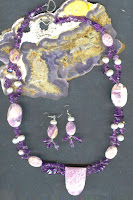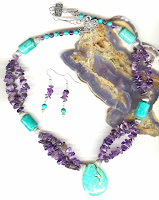 Lepodolite Jasper & Amethyst
Lepodolite Jasper & AmethystPURPLE is the new black ! Well, not quite. Will anything ever be the new black? But purple is this season's welcome addition to our beloved black. Be it grape or lilac, lavender or wine, violet, plum, puce, mauve, magenta, amethyst, pomegranate, eggplant or mulberry, there's no question that purple is the color of this fall and winter season. After all, we need something that is rich, luscious and exotic to liven up what has become an all-too-serious season of stripped-down, black-and-charcoal basics and bad financial times. Purple can bounce off of black, be used as a layering piece, or a shawl.
.
Indeed, not since the recessionary 1980s have we seen so much of the royal hue in our clothing, jewelry, accessories and even makeup. We're seeing other '80s-era jewel tones, too - fuchsia, teal and power red - but it's purple that's popping up most often on everyone from TV pundits to yoga teachers to bank tellers to stars striding along the red carpet. Purple, a perfect blend of hot red and cool blue, is that rare color that's flattering on everybody. Some hues are better on some people than others, of course - deep, royal purple looks great on people with dark, dramatic colouring, for instance, while warm, wine-y shades are terrific with golden skin tones and cool lavender is lovely on fair beauties. Purple is also one color whose mood changes depending on what it is paired with. It is a chameleon, becoming earthy when matched with browns and beiges, delicately feminine with pinks and other pastels, dramatically eccentric with brights like red or green, and seriously sophisticated with silver, charcoal, black and other cool neutrals. In fact, very dark and very light purples practically are neutrals, just a whisper away from black, navy or dove grey. Symbolically, purple has long had a wide range of meanings including nobility, regality, ritual, imagination, spirituality and creativity.
.
That's one of the reasons the color experts have chosen a shade of purple, "Blue Iris", as 2008's color of the year: "Combining the stable and calming aspects of blue with the mystical and spiritual qualities of purple, Blue Iris satisfies the need for reassurance in a complex world, while adding a hint of mystery and excitement." Long ago, purple was one of the most expensive, most difficult dyes to create, and so it was reserved for royalty. In coats of arms, it is still used to represent the gentry, and in military terms is awarded to the bravest, most noble of soldiers. It has also been a significant color for the ecclesiastical set, most notably for Roman Catholic bishops' robes, and has long been associated with spirituality, mysticism and the unknown. In many cultures, purple is also a color of mourning. Thai widows, for instance, traditionally wear purple, and during the Victorian era, purple was the transitional color for women in the period between deep mourning and the return to regular society.

Turquoise & Amethyst
More happily, though, it is also considered a creative color, the color of imagination, artistry, free-thinking and sensitivity. Many fashion experts believe that colors become popular not just because they are new and fresh and we're bored with last year's trendy shades, but because they resonate with the ethos of the times. So why purple, why now? Perhaps it is because, after a period of rampant excess and crass consumerism, we yearn to tap into our nobler selves, to seek a higher spirituality, to mourn the lost dreams of the North American middle class and to reconnect with our creative side. Or perhaps it's simply because it is beautiful, and it makes us feel beautiful when we wear it. And how you choose to wear purple is up to you - there is really no wrong or right way. You can keep it subtle, simply adding a touch of black currant eye shadow or the sparkle of an amethyst-coloured necklace to a black or grey outfit. Or you can add a bigger punch of drama with a magenta handbag, plum-coloured pump or a violet blouse or eggplant sweater under a businesslike jacket. Or you can go all out with high-impact pieces, like a purple party frock or mulberry puffer jacket.
.
But whether you go for subtle or spectacular, one thing for sure: it's a PURPLE reign this fall.
.
.
Composite articles from the Vancover Sun and The Chicago Sun Times..








 Information from various medical authorities indicate that even with a necklace containing as many London Blue Topaz as shown, the wearer would have to wear it 24 hours a day for many many years and they still would not receive as much radiation as one can obtain on a beach in the full sun.
Information from various medical authorities indicate that even with a necklace containing as many London Blue Topaz as shown, the wearer would have to wear it 24 hours a day for many many years and they still would not receive as much radiation as one can obtain on a beach in the full sun.















 .
.





























